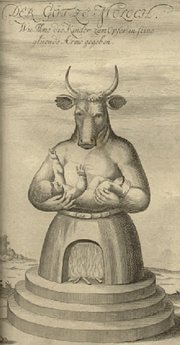Molech
From Plastic Tub
|
molech pn. 1. An ancient God to whom worshipped sacrificed valuable posessions, often in the form of human life. 2.A magician, illusionist or trickster. 3. euph. A scientist or a worker of marvels. ExtrapolationThe Filament of History In speaking of Molech one must be aware of the distinction between the general phenomena of Molechianism and the particular name itself as it refers to the Semitic manifestation. In Biblical Canaan, Molech -- or Moab, Ba’al – was worshipped as the Lord of Fire and God of War. The name itself is generally understood to mean “King” or, more generally, “owner.” In specifically Jewish traditions, Molech (מלך-Heb.) is most closely associated with Ba’al and was worshipped in the form of a golden, or copper calf during periods of strife and conflict. . In fact Molechian cults thrive wherever populations outgrow natural resources – in classically Malthusian sense, the god functions as a regulator of goods, such as access to food, water and arable land. Thus, Molechianism tends towards desert areas and thus explains the presence of such cults in the Middle East, Africa and, in certain cases, areas of the Americas. Ritual Formations Though Molech/Mormo could satiated through the spilling of both animal and human blood, the hungry God seemed to prefer infants – particularly those who were seen as valuable, such as Chieftain’s son. Sacrifice must hurt, basically, or it has no meaning to the community; to sacrifice a crippled beast, or plentiful fruits could bring the ire of the Godhead, resulting in losses in battle, plague and all manner of ill-fated incidents. This concept is illustrated aptly by the Semitic tale of Cain and Abel – Cain being cursed for offering fruits and vegetables, light fare indeed compared to brother Abel’s animal sacrifice. This metaphysical system acts in a manner familiar to many speculators in the Capitalist Stock Market – great risk, or sacrifice, yields greater returns. But also, there is the slow steady approach of the tortoise, a gradual amassment of comparatively smaller yields, in essence, substituting quantity for quality. This could explain the mass execution of innocent persons to be witnessed in the Old Testament, The Vedas and countless other sacred texts: the slaughter of hundreds or even thousands can substitute or surpass the offering of single prized child. Thus, the act of war itself – particularly those waged as acts of “ethnic cleansing” can be seen indeed as a form of worship, expiating the hungry god whose favors are bestowed from a river of innocent blood. Indeed, some researchers conflate any taking of life with Molechian sacrifice – the execution of prisoners, or abortion for instance. Believers in this view usually display pronounced Gnostic tendencies, such as those exemplified by The League of Gnomes and associated subgroupings. This line of thinking arises from the Gnostic belief in the evil of material existence, that is, its association with a False God, the entity responsible for suffering on the plane and whose efforts are directed at subverting the divine spark in man. This presents no subtle metaphysical quandary: the taking of a life removes it from the grips of the False God, sending the spirit hurtling beyond the material realm and into a renewed combat in the Pleroma. This view is curious, however, in that Molech is clearly identified as the creator of the World, indeed, of flesh – he is the False God for whom the blood sacrifice is meant to foil. As in certain Gnomic rituals, the child’s flesh is eaten by worshippers – though it’s important to note that child needn’t be killed; often, a single limb would be adequate repast and more rarely, fingers, toes or even ears, lips and noses. Surviving children so honored became the communal ward of the Tribe and were thought to have a keen sense of the God’s will and could be consulted for augurs and prophecy. Thanatologically Speaking In the end, nearly all human religious practice is Molechian in it’s preoccupation with death – all human worship exists to explain death, to assuage the worries of the living and to imbue the act of dying with metaphysical portent. The true Molechian, however, very nearly worships the act of dying – and more darkly, the act of killing. Life is defined by its cessation, its value autotelized by its limit. This metaphysical trade in death has powers of influence over the world of the living – if the God can be made drunk with innocent blood, his will becomes malleable and subject of human influence. The only issue to be decided then, is over what sphere Molech/Yahweh/Mormo reigns? Is he the creator of all things or simply a spiritual monstrosity, blind to his superiors, lost among the Pleroma as even man himself is lost inside his own flesh. Non-Canonical TextMolech enjoys notable ubiquity in the gnarled tradition of medieval Christian demonology; in fact, he appears as a kind of Superstar Prince of Hell, emboriodered with an astonishing variety of descriptive illumination. His province was believed, as expected, to be th realms of fire, war and curiously, dreams. In this latter capacity, Molech was alternately known as Mommu, a slight perversion of the Sumeria Mamu, the Lord of Dreams. Explicit references to Molech appear in Lev. 18:21, 20:2-5; Jer. 32:35 and II Kings 23:10. "Molech is a horrible beast, a soul-eater and a right bastard." So began Stimso Adid's exhaustive psychoanalytic study of Molech, The Oral God. See Also |
DesiderataIn the twentieth century, Molech has served as a popular metaphor in the arts. He features prominently in Allen Ginsberg's Howl and in Fritz Lang's Metropolis.
|

